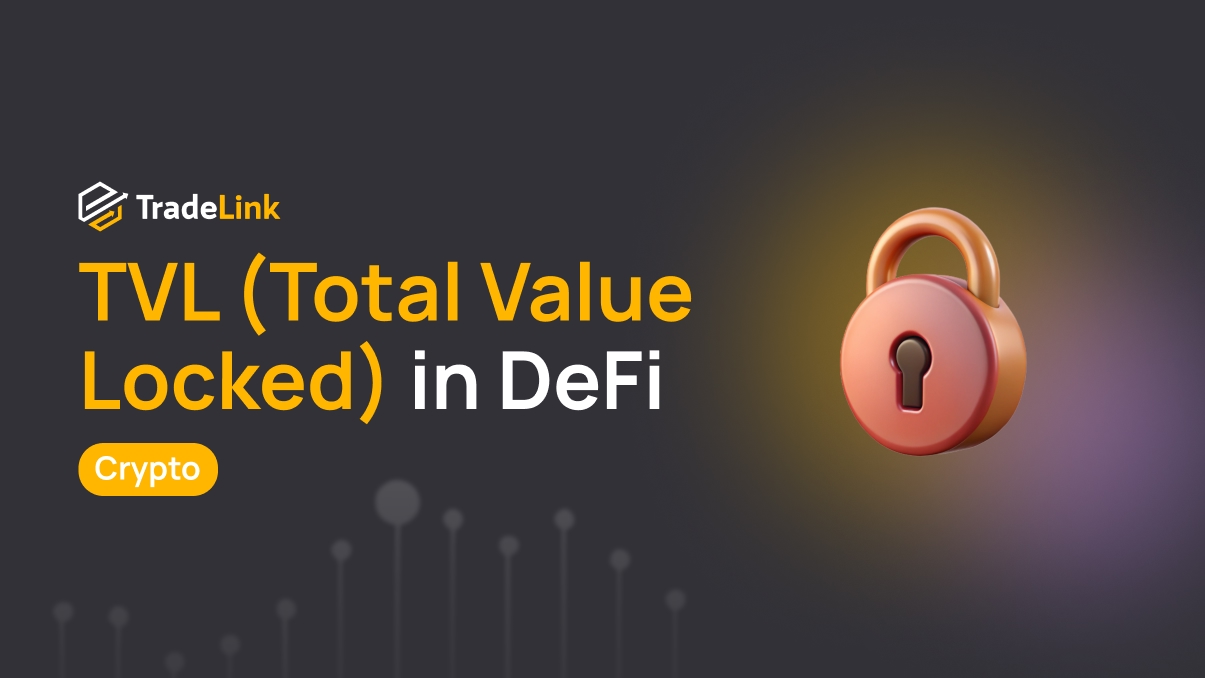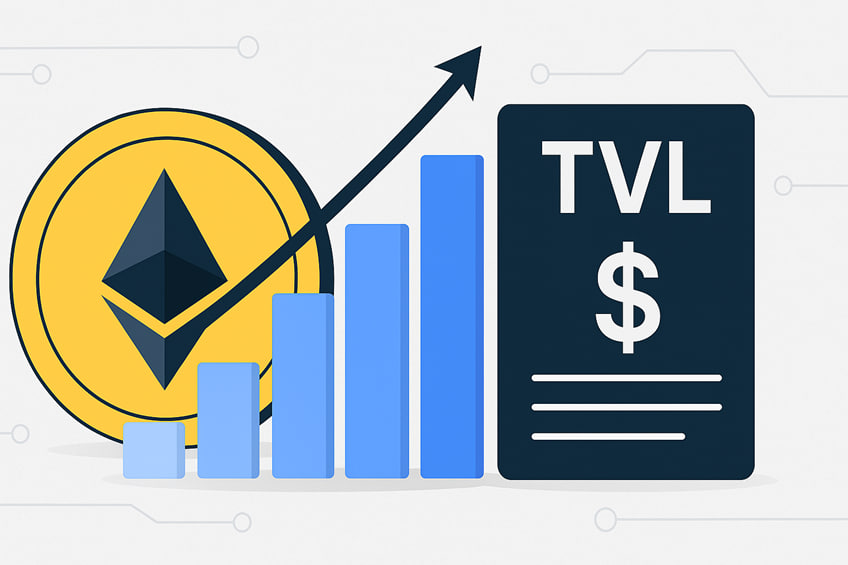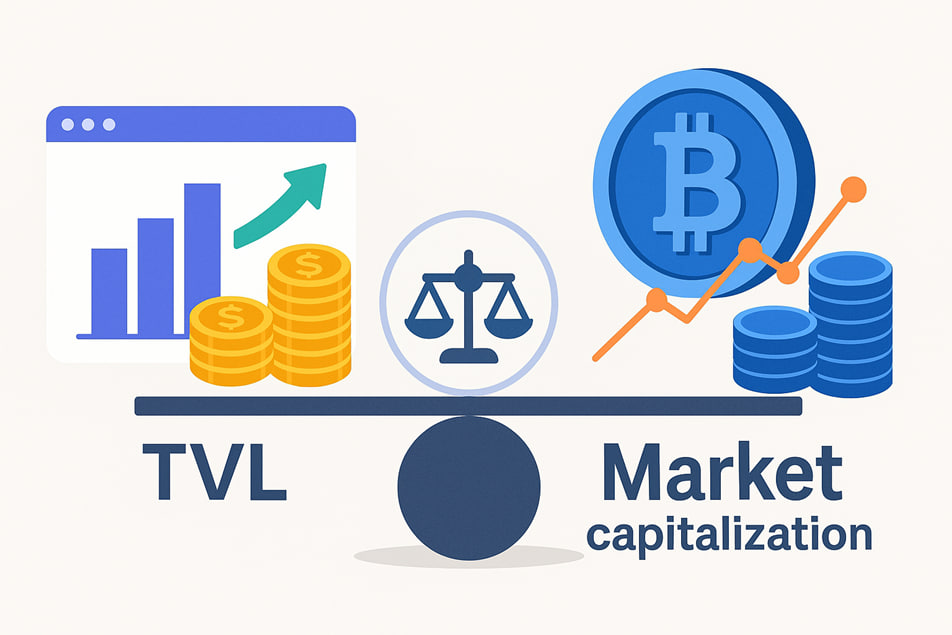TVL (Total Value Locked) in DeFi: What It Is & Why It Matters

Contents
- Introduction
- What is TVL in Cryptocurrencies
- Why TVL matters in DeFi
- TVL and market capitalisation
- Which protocols and networks lead in TVL
- Use cases for TVL analysis
- How TVL changes and what affects its growth
- The role of Layer 2 and multichain environments
- Limitations of TVL as a metric
- Conclusion
Introduction
In decentralised finance (DeFi), one metric is considered fundamental — Total Value Locked (TVL). The higher the TVL, the more liquidity and activity within the network.
This metric helps identify which projects are gaining interest, which are growing in popularity, and which are losing ground. TVL in DeFi reflects the overall state of the market and often serves as a benchmark for both developers and investors.
What is TVL in Cryptocurrencies

Total Value Locked — this is the total amount of funds that users have deposited into a protocol. These funds may be placed in liquidity pools, used for staking, or deposited for other purposes. All of this counts toward TVL. For example, if a user adds a pair of tokens to a swap pool and stakes coins to earn rewards, the protocol’s TVL is also increased.
Unlike trading volume, which reflects short-term activity, TVL shows long-term engagement. It helps assess how much users trust a protocol, since the funds remain locked in the system and continue to work within it. The core idea of this key DeFi metric is simple: the more value is deposited, the more is “locked” inside the system.
How TVL works
To calculate TVL, analytics platforms extract data directly from blockchains. They check how many tokens are held in smart contracts and multiply this by the current token price. For instance, if a contract holds 10 ETH and each is worth $2,000, the TVL for that contract is $20,000.
The token price may change — and TVL changes with it. Therefore, the metric reflects not only the amount of deposited value, but also the market’s general state. When prices drop, TVL drops too. But that doesn’t necessarily mean people are withdrawing funds — their holdings are just worth less.
Today, many protocols operate across multiple networks — a setup known as a multichain ecosystem. In this case, TVL is calculated separately for each chain and then aggregated across all chains. Since analysts may use different methods, TVL comparisons should always consider the data source.
Why TVL matters in DeFi
In the DeFi ecosystem, TVL is one of the most critical metrics. It indicates whether a protocol is active, the level of user trust it has, the commands it supports, and the number of resources it manages.
When TVL rises, it usually indicates that users are depositing more funds and not rushing to withdraw them. Such growth typically reflects that the protocol is functioning smoothly and evolving. Both investors and developers pay attention to this. A strong TVL boosts the likelihood of partnerships, improves rankings on aggregators, and attracts new users.
The volume of locked value is more than just a number — it’s a real indicator of trust and interest in a platform.
A signal of liquidity and trust
When a protocol has a high TVL, it means there are plenty of assets in the system. This enables participants to easily swap tokens, take out loans, or provide liquidity.
If a pool has sufficient funds, swaps happen quickly and with minimal slippage. When users leave money in a protocol without concern, it suggests they trust its safety. This matters for both newcomers and experienced users — no one wants to interact with a platform that has a poor reputation.
A high TVL in DeFi is often seen as a sign of stability. While it’s not a guarantee, it’s undoubtedly one of the first signals worth paying attention to.
Risk perception
TVL can fluctuate rapidly. A sudden drop is a significant warning sign. It may indicate that someone has withdrawn a large amount of capital, or that users are beginning to question the security of the protocol. Sometimes, a fall in TVL is linked to bugs, hacks, or smart contract failures.
At other times, TVL declines simply because the token price drops. This must also be taken into account. However, if a wave of withdrawals accompanies this decline, that’s a more serious warning.
A drop in TVL can signal that something is wrong. It doesn’t always mean disaster — but it warrants attention.
TVL and market capitalisation

Total value locked and market capitalisation frequently appear together in project overviews.
- TVL indicates the total value of users’ deposits into a protocol. This could be stablecoins, ETH, or other tokens. These funds aren’t idle — they actively fuel the platform.
- Market capitalisation, on the other hand, is calculated by multiplying a token’s price by its total supply. It doesn’t show how many assets are being used in the protocol. Sometimes a token’s price may surge, even if there’s almost no real activity behind it.
Therefore, it’s inappropriate to compare TVL and market cap directly. They don’t replace each other — they offer complementary views. TVL reflects practical utility; market cap reflects market sentiment.
The TVL/Market Cap ratio
This ratio helps to assess whether the market is valuing a project fairly.
- If the market capitalisation greatly exceeds the TVL, it may indicate that the token is overvalued. Its price is high, but there are very few actual assets in the protocol. In this case, the token’s outlook may be uncertain, as its value isn’t backed by real activity.
- Conversely, if the TVL is close to or even exceeds the market cap, the token might be undervalued. That could signal a promising opportunity.
The TVL-to-market-cap ratio helps identify projects with potentially mispriced tokens. It’s not a precise tool, but it serves as an effective additional filter.
Which protocols and networks lead in TVL
Ethereum leads in total value locked. It’s the largest blockchain network in the DeFi space, hosting more protocols than any other chain and holding the largest concentration of assets in its smart contracts.
According to DefiLlama, the top positions are held by networks and protocols that have proven their resilience and utility:
| Protocol | Category | Key Functions | TVL (approx., at time of publication) |
|---|---|---|---|
| Lido | Staking | Staking ETH, issuing liquid tokens (stETH) | $33B+ |
| Aave | Lending | Borrowing and lending, liquidity pools | $29B+ |
| EigenLayer | Re-staking | Reusing previously staked ETH | $17B+ |
All of these projects use locked assets as fuel. The more value they hold, the more powerful their ecosystems become.
Use cases for TVL analysis

Analysts often begin evaluating a project with its TVL. It helps them understand how popular a protocol is, how much trust it has earned, and how well it performs its functions. Here are several examples of how TVL analysis is used:
- If TVL is growing steadily, it’s a good signal. Increased activity and trust may indicate rising market interest.
- If TVL falls — especially sharply — it’s worth investigating the causes.
- Investors use this metric to find entry points. For example, if TVL begins to recover after a dip, that might signal a good time to buy.
Using TVL in analytics is a simple yet powerful decision-making tool — but it shouldn’t be used in isolation. It works best as part of a broader, multi-metric approach.
How TVL changes and what affects its growth
The total value locked never stays still. It rises when market interest increases and falls when investor confidence weakens.
Investors play a significant role. When they believe in a project, they commit capital. That might be through staking, yield farming, or providing liquidity. New products, favourable conditions, and protocol upgrades also attract users.
Major economic shifts can also affect TVL. For instance, rising interest rates or regulatory news may prompt people to withdraw funds from protocols.
The role of Layer 2 and multichain environments
Previously, TVL was usually measured in a single network — most often Ethereum. Today, that no longer works. New protocols now operate across multiple blockchains.
Layer 2 networks such as Arbitrum and Optimism offer faster transactions and lower fees. This makes them attractive, and more users are migrating there.
If TVL is calculated for only one network, it can distort the picture. Assets can be transferred to another ecosystem while remaining within the same protocol.
The multichain approach gives a more accurate view of a project’s absolute scale. That’s why analysts now measure TVL across all networks where a platform operates.
Limitations of TVL as a metric

TVL is a helpful metric, but it doesn’t provide a complete picture. For example, it doesn’t reveal whether a platform is profitable. A protocol may have a high TVL, yet generate low revenue.
It also doesn’t show how many users are interacting with the protocol. A large TVL might come from just a few big investors who lock in assets but don’t actively engage with the platform.
Why can’t you rely on TVL alone
You can’t judge a project based solely on TVL. It’s just one indicator, not the whole story.
To gain a deeper understanding, consider factors such as trading volume, the number of active addresses, fee structures, and other relevant data points.
A high TVL may be masking hidden problems. Conversely, a low TVL doesn’t always mean failure. The project might be new or still in its early stages.
That’s why TVL analysis only works when combined with other metrics. It’s a tool — not a definitive answer.
Conclusion
TVL is a key metric in the DeFi world. It helps show how much capital users are entrusting to a protocol and the level of demand the platform has.
But TVL alone won’t give you the whole picture. It doesn’t reflect revenue, doesn’t count users, and can shift just because token prices change.
To use this metric wisely, always compare it with other data. That way, TVL becomes genuinely helpful — and helps you make informed, accurate decisions.